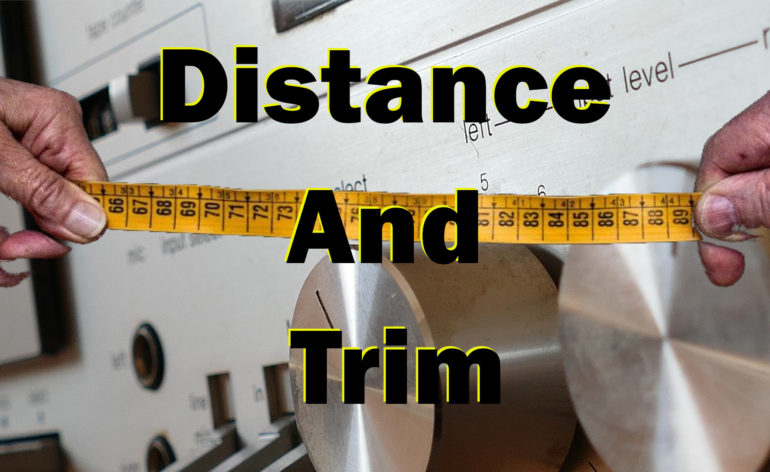Speaker Distance and Trim Settings: The Most Counterintuitive Settings in Home Theater?
Engineers are wonderful people. We need them. They invent stuff. They make our lives easier, our food warmer, and our houses less fall-down-y. But, after meeting quite a few and marrying one, I can say this: They are not great at naming things. Take the speaker distance and trim settings in your AV receiver. They would seem at first blush, to make sense. But you’d be very, very wrong. Let’s take these settings and really understand what they do. Because it really isn’t what it seems.
What We Think the Speaker Distance and Trim Settings Do
If you look at the speaker distance and trim settings in your AV receiver, you’ll notice their inputs. The speaker distance setting requires a measurement (in feet or meters) and the trim setting can be adjusted usually by +/-10dB (or +/-12dB). Clearly, the distance setting feeds the trim setting, right? Your AV receiver needs to know the distance from your seat to the speakers in order to adjust the trim so that all the speakers play the same volume. Easy! Article done!
We Are Not Close to Done
First, it is important to know when the speaker distance and trim settings are used. The AV receiver, during its setup, will play test tones. Using the included microphone, it’ll measure the sounds from each speaker and set the distance and trim levels for each speaker. If you take out a tape measure and run it from the microphone to each speaker, you are going to get a number that is remarkably close to the one under the distance setting.
Except for the subwoofer.
The subwoofer distance is often very, very wrong. So wrong, that some people want to send back their receivers because they think they are clearly broken. The distance setting for the subwoofer might be so large as to not be in the room. Maybe not even be in the house. This is normal. It is also an indication that the distance setting really doesn’t have to do with distance at all.
What Trim Setting Actually Does
The trim setting in your AV receiver isn’t actually connected to the speaker distance at all. The microphone measures the volume of the test tone played from each speaker and adjusts the trim level up or down so that every speaker is at the same volume. Since it has no idea what speakers you are using, or what their capabilities are, the distance they are from the microphone is immaterial. All it knows is how much it can and should adjust the volume to level match all your speakers. They could be three or fifty feet away. The number under the distance setting is immaterial.
What The Distance Setting Actually Does
The speaker distance setting in your AV receiver is completely unconnected to the trim. That’s because the receiver, again, doesn’t care where your speakers are in your room in relation to your seat. The distance setting is actually an audio delay. What the distance setting is actually doing is applying a delay to each channel so that the sounds arrive at the microphone at the same time. For most of your speakers, the audio delay is directly connected to how far away they are from the microphone. The further they are, the more you have to delay the other speakers in order for all the sounds to arrive at the same time. Engineers used feet and meters so that it made more sense to users. But it would be more accurate to have a millisecond delay rather than feet and meters.
As we’ve discussed, subwoofers are different. The bass waves are longer than almost any room you put them in. A 20Hz note has a wave that is over 55 feet long. This means that the sound needs to bounce off of at least one if not multiple walls before it completes that wave. That’s why the subwoofer distance setting is so different from the other speakers (and why a delay setting would be more accurate). The sound wave is taking longer to completely form in the room therefore it arrives at the microphone far after all the other speakers. Sure, the subwoofer might be sitting right next to another speaker, but don’t be surprised if your room correction sets a completely different distance.
The Short Version
The speaker trim and distance settings aren’t exactly what they sound like, and aren’t actually interconnected as they may seem. The trim makes sure that the sound that reaches your seat is all the same volume. The distance setting makes sure the sound all arrives at the same time. While the physical distance from your seat to each speaker are correlated, it doesn’t mean that they are the same. So don’t be weirded out if you see a distance setting that doesn’t match the physical distance.
In the same vein, the trim levels can be affected by many things in your room. You may have two identical speakers in your room. They may be the same distance from you. But they are in two different areas. The acoustics in those different spaces may affect how the trim levels are set. If you see that one is different than the other, it may be simply because of your room.


